

Ambient Help - Office of the CTO. UIE Newsletter - On Surveys. Surveys are the most dangerous research tool—misunderstood and misused.

They frequently straddle the qualitative and quantitative, and at their worst represent the worst of both. In tort law the attractive nuisance doctrine refers to a hazardous object likely to attract those who are unable to appreciate the risk posed by the object. In the world of design research, surveys can be just such a nuisance. Easy Feels True It is too easy to run a survey. A lot of important decisions are made based on surveys. Easy Feels Right The problem posed by this ease is that other ways of finding an answer that seem more difficult get shut out.
Breaking down content silos: expectation vs. reality. Intercom.Oct_.Web_.pdf. The Top 6 Questions to Ask When Creating Your Content Strategy. Illustration by Frits Ahlefeldt-Laurvig We often get so caught up in the task of creating content that we easily forget the foundation of what content strategy is all about.
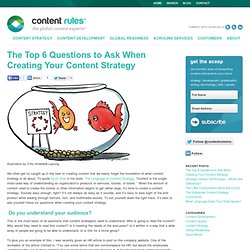
To quote Scott Abel in his book, The Language of Content Strategy, “Content is the single most-used way of understanding an organization’s products or services, stories, or brand.” When the amount of content used to create the stories or other information begins to get rather large, it’s time to create a content strategy. Sounds easy enough, right? It’s not always as easy as it sounds, and it’s easy to lose sight of the end product while wading through formats, text, and multimedia assets. Do you understand your audience? This is the most basic of all questions that content strategists need to understand. To give you an example of this, I was recently given an HR article to post on the company website. Do you understand business goals? What is the end objective of your organization? Do you know your delivery options? 5 Content Marketing Lessons You Don’t Want to Learn the Hard Way.
Content marketing isn’t rocket science, but that doesn’t mean it’s easy either.
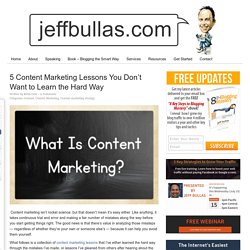
Like anything, it takes continuous trial and error and making a fair number of mistakes along the way before you start getting things right. The good news is that there’s value in analyzing those missteps — regardless of whether they’re your own or someone else’s — because it can help you avoid them yourself. What follows is a collection of content marketing lessons that I’ve either learned the hard way through the mistakes I’ve made, or lessons I’ve gleaned from others after hearing about the challenges they’ve faced. Hopefully reiterating those lessons here, along with some sound advice, helps to save you some time and frustration.
Lesson #1: You need at least one dedicated resource. A lot of companies, particularly small ones, think that they can tack content marketing on to their existing marketing team’s responsibilities without adding any headcount. Lesson #2: You need a strategy. Positioning Content for Success – A Metrics Driven Strategy. Tech Comm as Craft or Commodity (poll) Recent blog posts, webinars, conference sessions, and list debates have been creating a storm of very lively debate over a nearly ageless topic–the future of technical writing.
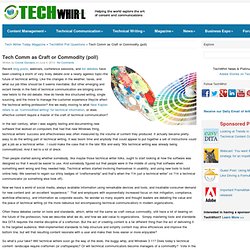
Like the changes in the weather, taxes, and what our job titles should be it seems inevitable. But other emerging and extant trends in the field of technical communication are bringing some new twists to the old debate. How do trends like structured writing, single sourcing, and the move to manage the customer experience lifeycle affect the technical writing profession? Are we really moving to what Neal Kaplan refers to as “commodified writing” for technical information, or does effective content require a master of the craft of technical communication? In the last century, when I was eagerly testing and documenting new software that worked on computers that had that new Windows thing, technical writers’ success and effectiveness was often measured by the volume of content they produced.
Verizon is taking Subscription Learning Seriously! - Subscription Learning. Michael Sunderman, Executive Director, Verizon Training and Development, is a big believer in subscription learning.
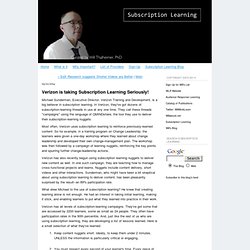
In Verizon, they've got dozens of subscription-learning threads in use at any one time. They call these threads "campaigns" using the language of QMINDshare, the tool they use to deliver their subscription-learning nuggets. Most often, Verizon uses subscription learning to reinforce previously-learned content. So for example, in a training program on Change Leadership, the learners were given a one-day workshop where they learned about change leadership and developed their own change-management plan.
The workshop was then followed by a campaign of learning nuggets, reinforcing the key points and spurring further change-leadership actions. Strategy Maps. The word Strategy, when applied to Market Analysis, risks to be used as a buzzword that means everything and nothing.
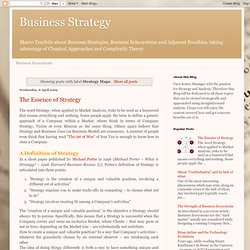
Some people apply the term to define a generic approach of a Company within a Market; others think in terms of Company Strategy, Vision or even Mission as the same thing. Others again believe that Strategy and Business Case (or Business Model) are synonyms. Positioning Content for Success – A Metrics Driven Strategy. HBR Porter Strategy.